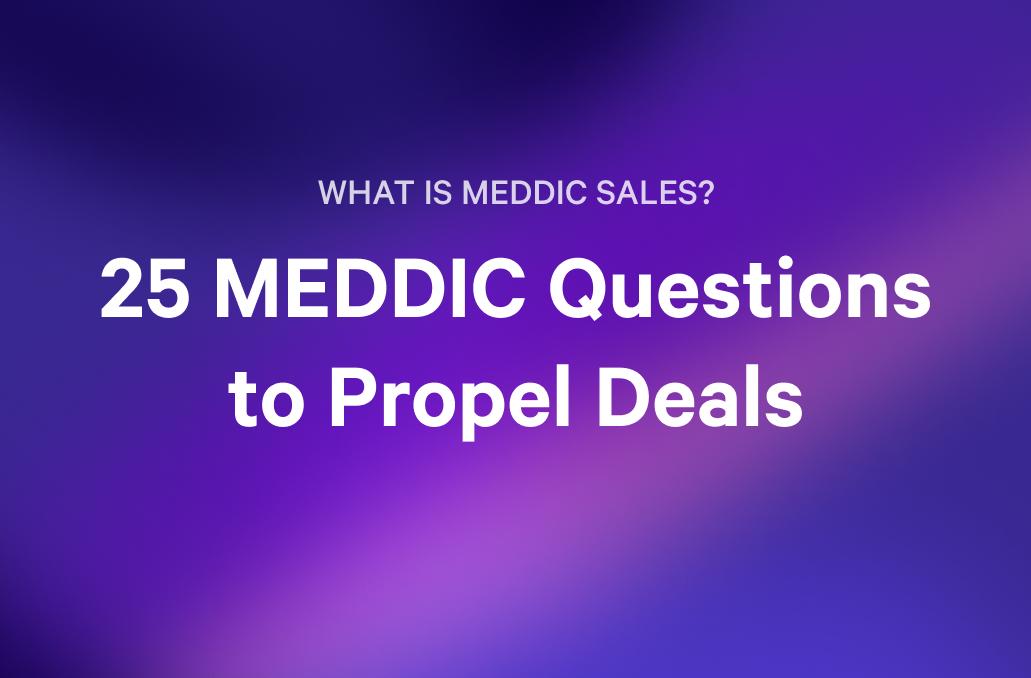MEDDIC vs. Challenger - Which Methodology Do You Need?
With so many sales methodologies to choose from, it’s not easy to pick the right one for your organization.
You'd be forgiven for thinking any system is better than no system at all. According to CSO Insights, if your workforce is prepared to implement your chosen sales methodology on a daily basis, you’re likely to see above-average gains for revenue plan attainment, quota attainment, and win rates.
However, are some sales methodologies more ‘above-average’ than others? How do you know if you’ve chosen the wrong methodology? Does it ever make sense to combine elements of multiple strategies?
In this article, we’re going to answer these questions and more, with a side-by-side comparison looking at the pros and cons of two of the most popular methodologies, MEDDIC and Challenger (sometimes called The Challenger Sale) .
We’ll take a high-level overview of these contrasting systems and provide some hypothetical scenarios. This article will help you gauge whether your sales organization could benefit from the MEDDIC sales methodology or Challenger (or both).
Key takeaways
- Both methodologies are suited to long sale cycles and complex high-ticket offers.
- Depending on your specific industry, product, or service, either approach—or even a combination of both—might best meet your needs.
- MEDDIC is most useful when attempting to sell to large buying teams with complicated decision-making processes; Challenger sales suits innovative products and strong USPs.
What is MEDDIC?
Developed by Jack Napoli and Dick Dunkel in the early 1990s, MEDDIC is considered by many as not so much a true sales methodology as a comprehensive qualification framework. It may come in handy in the early stages of your sales process.
The MEDDIC methodology's methodical research and probing questions generate a great deal of relevant information about the prospect. This information drives the early stages of a sales process and often defines how we negotiate and close, too.
The MEDDIC sales methodology (or MEDDIC framework) is built into an acronym that stands for:
- Metrics: Or how your clients measure the value you bring to them when you sell in your solution.
- Economic Buyer: The person with the purchasing authority in your client or prospect’s organization.
- Decision Criteria: The benchmarks, features, or other criteria used to make a purchase decision.
- Decision Process: The process the organization goes through to make the decision. This could be how (and when) a prospect will evaluate a product or service.
- Identify Pain: What is the pain point that the prospect is looking to address with your solution?
- Champion: The person (or group of people) internally advocating for you and your product or service.
The MEDDIC sales process is also adaptable, as evidenced by the evolution of several variations. These include MEDDPPIC, which adds ‘paper processes’ to the acronym, allowing sales professionals to track and evaluate the administrative processes involved at every stage of the sale.
MEDDIC is invaluable in more complex sales and buying processes involving buying teams, multiple stakeholders, and decision makers.
It’s much less relevant for smaller, simpler buying decisions and sales processes. In these contexts, it makes no sense to implement MEDDIC. There is little need to intensively research decision processes, decision criteria or possible champions when the decision to buy is made informally by an individual or small team.
What is Challenger?
Still the new kid on the sales methodology block, 'The Challenger Sale' book and corresponding methodology turned the sales world on its head when it was published in 2011 by Gartner researchers Matthew Dixon and Brent Adamson.
Interviewing and profiling thousands of sales professionals, Dixon and Adamson developed five distinct salesperson personas to help them categorize the different selling approaches. They found that over 50% of the most successful salespeople were using techniques and approaches associated with the ‘challenger’ profile.
The challenger type uses their understanding of their customers’ businesses to deliver new insights and influence the customer’s thinking differently.
They actively seek out new ideas and perspectives that the customer hadn’t previously considered or fully appreciated. They’re unafraid to ‘challenge’ the customer’s understanding of the status quo, creating constructive tension that they seek to resolve by changing the customer’s perception. The resulting emotional impact helps to position the salesperson as a trusted advisor.
Challenger works best for sales conversations in which the sales professional’s understanding of the product, industry, and typical pain points is equal to or greater than the customer’s understanding. It’s also well suited to innovative new products or services or situations where the salesperson can demonstrate a strong USP.
It’s not always ideal in well-defined, mature markets, where companies compete on price. It can also be tricky to deploy in markets for highly specific technical products and services. These often require salespeople with a high degree of specialized knowledge (and the confidence to deliberately create tension with a prospect).
Comparing MEDDIC vs. Challenger?
| Feature | MEDDIC | Challenger |
|---|---|---|
Area of focus | Sales qualification | Customer experience and sales development |
Best for… | Selling complex offers to customers with buying teams | Selling innovative products and services with a strong USP |
Worst for… | Selling to customers with sole decision-makers and unstructured buying processes | Transactional sales, highly specific technical markets |
Level of organizational buy-in required | High - sales and marketing will need to cater at all levels for the data involved in successful implementation | Primarily reps and sales enablement (possibly SDR/technical sales involvement) |
Implementation time | Medium - sales team will need training in the method, ‘paper processes’ and data capture infrastructure will need designing and testing | High - Challenger relies on highly experienced, confident sales professionals with specialist product knowledge. Time and training-intensive |
Additional training needed | A light but broad iterative approach to training, rewarding curiosity. Emphasize ground-up feedback processes | Both the methodology and the product/industry knowledge required to provide customer-relevant insights dictate a significant training commitment |
Selling experience needed | No requirement for high levels of experience | Experienced sales reps only |
High ticket/low ticket | High ticket | High ticket |
Long sales cycle/short sales cycle | Long sales cycle | Long sales cycle |
How to decide between MEDDIC vs. Challenger
It’s often easier to understand the benefits and shortcomings of different sales methodologies by examining how a sales organization could deploy them in real-world scenarios. Here are some use cases to give you an idea of how implementing MEDDIC sales approaches or the Challenger sales model would work in practice.
Use case #1: Public sector managed IT services
Government and public sector buying processes are notoriously complicated and protracted. Along with a comprehensive RFP or tendering process, there’s often additional layers of background checks and regulatory compliance to contend with.
This due diligence often requires a large buying team representing a broad and sometimes conflicting range of interests. The different members of this team will bring together specific expertise from fields as diverse as housing, public health, utilities and database management.
🏆 Verdict: MEDDIC.
This is the perfect scenario for MEDDIC. Understanding the complex interactions and needs of this buying team is key to improving win rates with a target account selling approach.
Challenger types might not find themselves welcome in this sales environment. Even if they have an encyclopedic knowledge of multiple fields within the public sector, the differing needs of different municipalities, counties, and boroughs will make it difficult to generate insights that the customer hasn’t already considered.
Challenger types might not find themselves welcome in this sales environment. Even if they have an encyclopedic knowledge of multiple fields within the public sector, the differing needs of different municipalities, counties, and boroughs will make it difficult to generate insights that the customer hasn’t already considered.
Use case #2: Financial advisor services
Financial advisors work with a broad spectrum of clients, ranging from wealthy entrepreneurs to large corporations and enterprise clients. They provide specialized services such as risk management or investment solutions, as well as advice that changes significantly according to constantly evolving market conditions.
A trusted advisor is expected to provide a level of expertise that the client simply can’t provide for themselves. The client might not necessarily rely on a large buying team to help them select their financial services. This means the ability of the person selling the services to demonstrate their ability and track record is crucial.
🏆 Verdict: Challenger.
Challenger types are well-positioned to succeed in selling financial services. Solving the client's problem with a conceptual selling approach is a natural fit for this industry. Their innate desire to push back at the client’s preconceptions and establish new perspectives will also help them establish their credibility and authority.
The variety in client size and organizational structure would leave MEDDIC-style sales teams out in the cold, with no real consistency of approach to help them develop their toolkit.
Use case #3: B2B cloud network solutions
Businesses large enough to require their own private network, often with additional cybersecurity and extensive backup options, aren’t likely to rush the implementation - or procurement - of any new network solution.
They’re also likely to look for future-proofed solutions that employ the latest technology. Much of the old equipment they’ll be throwing out may well be expected to last several years and integrate with technologies that are still emerging.
🏆 Verdict: Both.
A mature sales enablement strategy is common among telecoms, SaaS companies and internet service providers. Salespeople thriving in this industry will usually rely on a great deal of specialized knowledge. They're likely to have plenty of experience of explaining innovative new technologies to customers - even when the customer already brings considerable technical knowledge to the table.
This is a natural situation for Challenger sales approaches. The size and organizational structure of typical clients for this industry mean that the MEDDIC sale approach will also yield benefits when navigating the complex buying teams and decision-making processes involved in procuring network solutions.
Use case #4: Wholesale plumbing supplies
While the plumbing industry experiences trends and fluctuations like any other industry, it’s also a remarkably stable market, based on consistent and easily predicted levels of demand.
Market dominance in any given region is usually decided by unchanging or slowly changing conditions such as geography, or availability of cheap imports and materials. The technologies used are comparatively simple, with little room for innovation.
🏆 Verdict: Neither.
There’s probably still some viable tactics open to plumbing wholesale suppliers looking to improve their existing sales. But neither MEDDIC nor Challenger are going to cut the mustard here. There’s not much for Challenger types to discuss other than price, and MEDDIC-style investigations aren’t likely to yield much worth knowing.
Don’t rush your methodology
As these use cases demonstrate, every industry and market provides different conditions that govern your sales methodology. If you’re lucky enough to find a methodology that perfectly matches your present and future conditions, then there’ll be a wealth of resources and strategies at your disposal.
However, if (like most industries) your needs are more specific, then you might want to consider a more nuanced approach. Experiment by drawing on features of different methodologies and adding new letters. You might even create your own sales acronym.
Qwilr’s extensive library of templates contains customizable proposals built to complement and reflect popular selling methodologies such as Challenger, MEDDIC, and SPIN. Using these templates as a starting point, you can instantly edit and sculpt your sales collateral to match your industry, your selling approach and strategies, no matter how specific your market.
Try Qwilr for free for two weeks, and you’ll see how the perfect proposal can shape and drive your sales approach.
About the author

Dan Lever|Brand Consultant and Copywriter
Dan Lever is an experienced brand consultant and copywriter. He brings over 7 years experience in marketing and sales development, across a range of industries including B2B SaaS, third sector and higher education.
Frequently asked questions
MEDDPICC is an updated version of MEDDIC, designed to reflect the potential for more complicated modern buying processes (the extra ‘p’ stands for ‘paper processes’). MEDDIC is an adaptable framework.
You can learn to implement MEDDIC sales approaches fairly quickly, with a recognized MEDDIC certification taking between five and 16 hours of training for each sales rep.
SPIN selling focuses on using questions to uncover customer needs and new information. Challenger selling mainly uses questioning to establish the customer’s baseline perceptions and assumptions before ‘challenging’ those perceptions to provide a new perspective.




